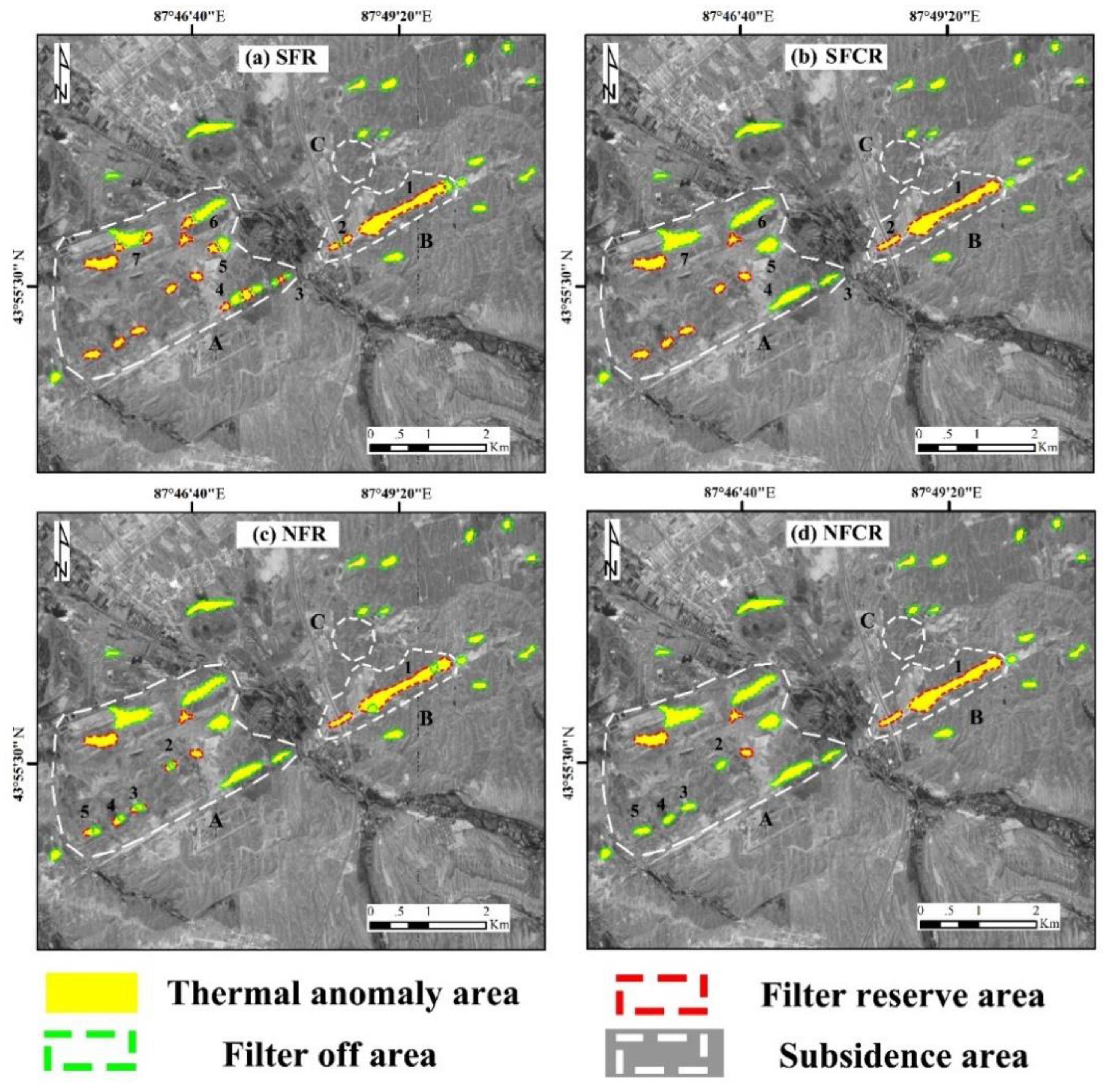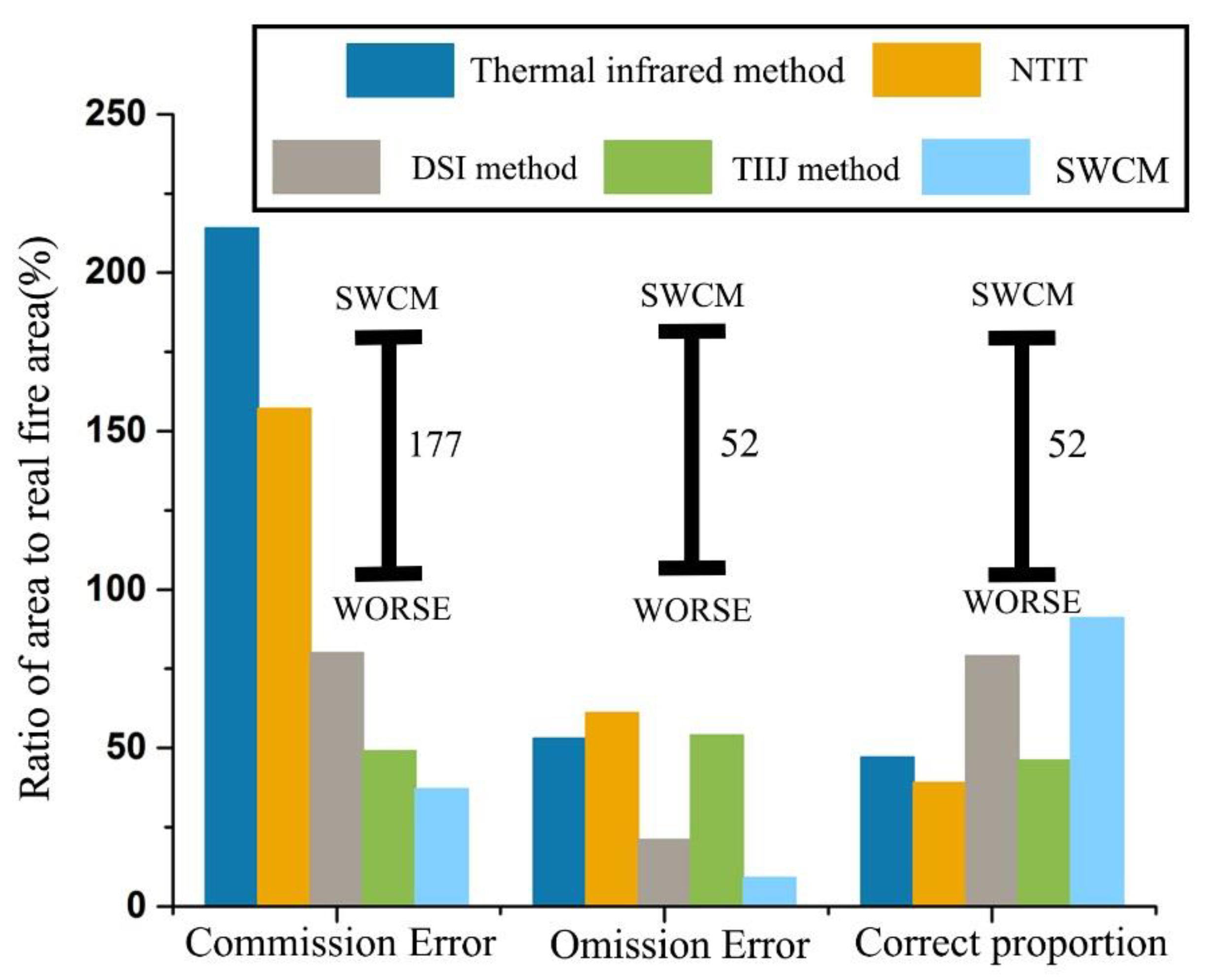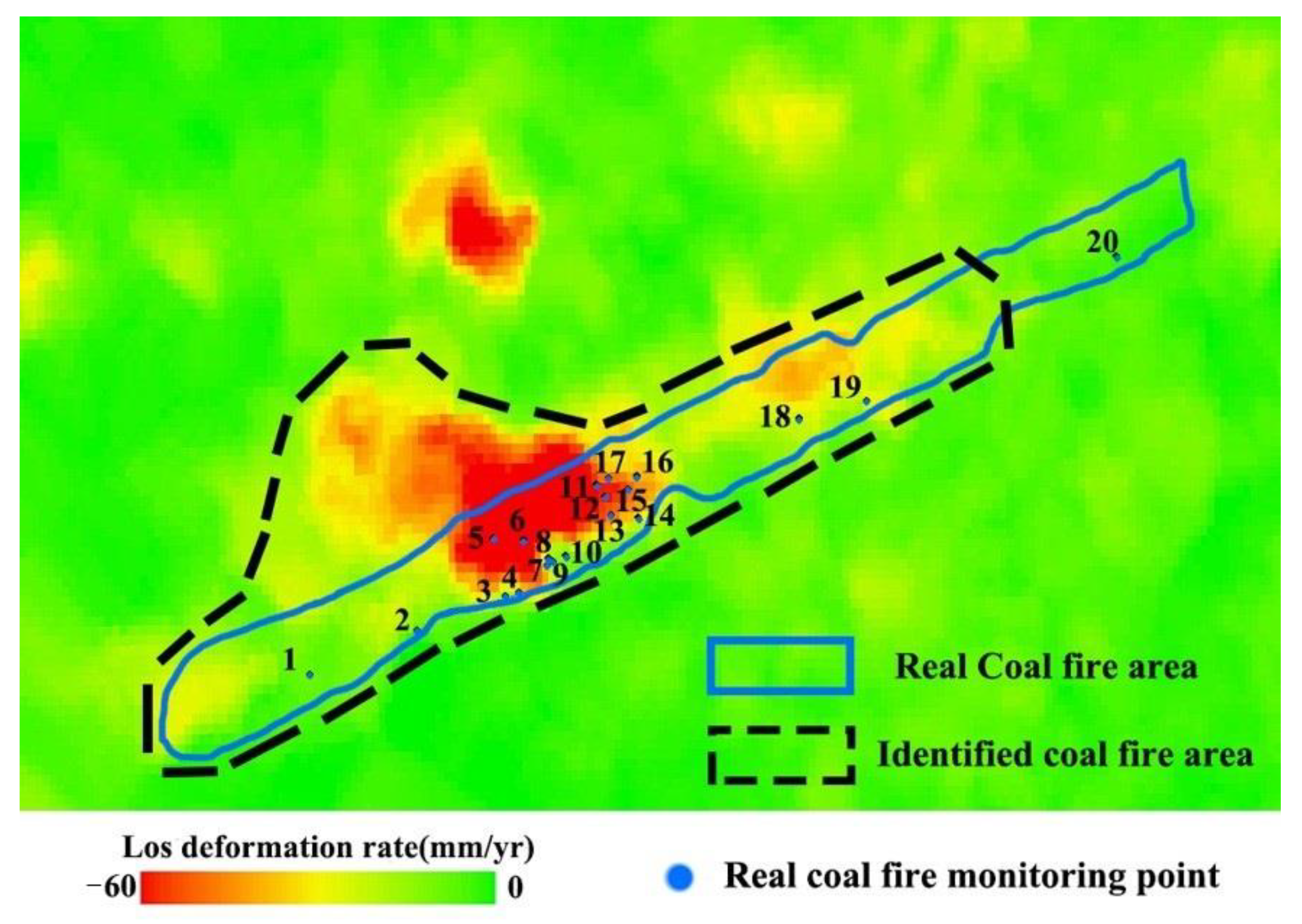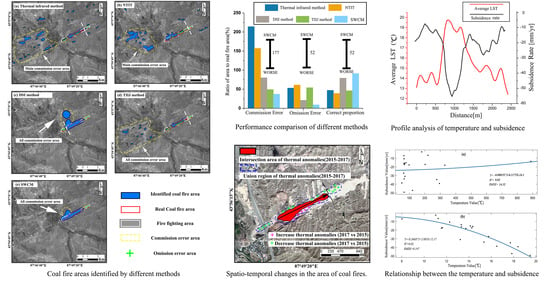Underground Coal Fire Detection and Monitoring Based on Landsat-8 and Sentinel-1 Data Sets in Miquan Fire Area, XinJiang
Abstract
1. Introduction
2. Study Area and Datasets
2.1. Study Area
2.2. Datasets
3. Methods
3.1. Temperature Inversion and Thermal Anomaly Extraction
3.2. NDVI Inversion
3.3. Subsidence Information Inversion
3.4. Joint Processing of Three Remote Sensing Parameters
3.4.1. Strong Constraint Process
- Reasonable thresholds are established to extract thermal anomaly, subsidence anomaly, and NDVI anomaly areas. The thresholds corresponding to thermal, subsidence, and NDVI anomalies are obtained by the self-adaptive gradient-based thresholding (SAGBT) method [32,35], the standard deviation of subsidence based on distributed scatterer interferometry (DSI) [36,37,38], and the sum of the mean and standard deviation of NDVI, respectively.
- A subsidence filter is prepared to filter the thermal anomaly area for obtaining the subsidence filtering result (SFR), which is then corrected to attain the subsidence filtering correction result (SFCR).
- NDVI filter is prepared to perform NDVI filtering on SFCR to obtain the NDVI filtering result (NFR), which is then corrected to derive the NDVI filtering correction result (NFCR).
3.4.2. Weak Constraint Process
- According to the risk level of suspected coal fires, the preliminary coal fire areas and the suspected coal fire areas are determined, and the weak constraint determination area is obtained. Specifically, the NFCR in the high/extremely high suspected coal fire area indicates the preliminary coal fire areas, and the NFCR in the other risk levels of suspected coal fire areas indicates the suspected coal fire areas. Then, the areas of the high/extremely high suspected coal fire, except the preliminary coal fire areas, are judged as weak constraint areas.
- The temperature, subsidence, and NDVI information in the weak constraint areas are statically analyzed. Further, according to the anomaly threshold calculation method described in Section 3.4.1, the threshold values of thermal anomaly, subsidence anomaly, and NDVI anomaly are obtained. The areas that meet any two kinds of anomaly thresholds indicate the omission errors of coal fire areas, otherwise, they are judged as non-coal fire areas.
- The initial coal fire areas and the omission errors of coal fire areas are the final coal fire areas.
4. Results and Analysis
4.1. Temperature Inversion and Thermal anomaly Extraction
4.2. Coal Fire Areas Based on Strong and Weak Constraints
4.3. Coal Fire Detection Accuracy
4.4. Spatio-temporal Evolution of Coal Fires
4.5. Relationship between Temperature and Subsidence of Coal Fires
5. Discussion
5.1. Feasibility and Effectiveness of the Proposed Strong and Weak Constraints Method (SWCM)
5.2. Relationship between Surface Temperature and Subsidence in Coal Fire Areas
6. Conclusions
- The results demonstrate that the proposed method has a good performance on the commission error rate, omission error rate, and identification accuracy of the coal fire area over the study area. Specifically, these three parameters are 9%, 37%, and 91%, respectively. Compared with the four conventional methods, the average commission error rate and omission error rate are decreased by 70.4 %, 30.6%, respectively. The average identification accuracy of the coal fire area is increased by 30.6%.
- Spatio-temporal changes of coal fires have been analyzed. The coal fire tended to spread to the southeast from 2015 to 2017, and its reduction range was 2.8 times that of its increase range, so the overall combustion areas showed a decreasing trend over the study area.
- The relationship between the temperature and subsidence of coal fire areas is investigated. The time-series average temperature of the coal fire areas has a strong negative correlation with the ground subsidence rate, and the correlation coefficient was 0.82 from 2015 to 2017. Nevertheless, more precise relationships between them over the coal fire areas need further investigation.
Author Contributions
Funding
Institutional Review Board Statement
Informed Consent Statement
Data Availability Statement
Acknowledgments
Conflicts of Interest
References
- Kuenzer, C.; Stracher, G.B. Geomorphology of coal seam fires. Geomorphology 2012, 138, 209–222. [Google Scholar] [CrossRef]
- Kuenzer, C.; Zhang, J.; Sun, Y.; Jia, Y.; Dech, S. Coal fires revisited: The Wuda coal field in the aftermath of extensive coal fire research and accelerating extinguishing activities. Int. J. Coal Geol. 2012, 102, 75–86. [Google Scholar] [CrossRef]
- Pandey, J.; Kumar, D.; Panigrahi, D.C.; Singh, V.K. Temporal transition analysis of coal mine fire of Jharia coalfield, India, using Landsat satellite imageries. Environ. Earth Sci. 2017, 76, 1–13. [Google Scholar] [CrossRef]
- Song, Z.; Kuenzer, C. Coal fires in China over the last decade: A comprehensive review. Int. J. Coal Geol. 2014, 133, 72–99. [Google Scholar] [CrossRef]
- Jianxin. Solving the problem of underground coal fire prevention and control in China. Mine Constr. Technol. 2018, 39, 9. [Google Scholar]
- Gangopadhyay, P.K.; Lahiri-Dutt, K.; Saha, K. Application of remote sensing to identify coalfires in the Raniganj Coalbelt, India. Int. J. Appl. Earth Obs. Geoinf. 2006, 8, 188–195. [Google Scholar] [CrossRef]
- Kumar, S.; Kumar, D.; Chaudhary, S.K.; Singh, N.; Malik, K.K. Land subsidence mapping and monitoring using modified persistent scatterer interferometric synthetic aperture radar in Jharia Coalfield, India. J. Earth Syst. Sci. 2020, 129. [Google Scholar] [CrossRef]
- Shao, Z.; Jia, X.; Zhong, X.; Wang, D.; Wei, J.; Wang, Y.; Chen, L. Detection, extinguishing, and monitoring of a coal fire in Xinjiang, China. Environ. Sci. Pollut. Res. 2018, 25, 26603–26616. [Google Scholar] [CrossRef] [PubMed]
- Syed, T.H.; Riyas, M.J.; Kuenzer, C. Remote sensing of coal fires in India: A review. Earth-Sci. Rev. 2018, 187, 338–355. [Google Scholar] [CrossRef]
- Sofan, P.; Bruce, D.; Jones, E. Detection and Validation of Tropical Peatland Flaming and Smouldering Using Landsat-8 SWIR and TIRS Bands. Remote Sens. 2019, 11, 465. [Google Scholar] [CrossRef]
- Sofan, P.; Bruce, D.; Jones, E. Detecting Peatland Combustion using Shortwave and Thermal Infrared Landsat-8 data. In Proceedings of the VIII International Conference on Forest Fire Research, Coimbra, Portugal, 9–16 November 2018. [Google Scholar]
- Huo, H.; Jiang, X.; Song, X.; Li, Z.L.; Ni, Z.; Gao, C. Detection of coal fire dynamics and propagation direction from multi-temporal nighttime landsat SWIR and TIR data: A case study on the Rujigou Coalfield, Northwest (NW) China. Remote Sens. 2014, 6, 1234–1259. [Google Scholar] [CrossRef]
- Voigt, S.; Tetzlaff, A.; Zhang, J.; Künzer, C.; Zhukov, B.; Strunz, G.; Oertel, D.; Roth, A.; van Dijk, P.; Mehl, H. Integrating satellite remote sensing techniques for detection and analysis of uncontrolled coal seam fires in North China. Int. J. Coal Geol. 2004, 59, 121–136. [Google Scholar] [CrossRef]
- Chatterjee, R.S. Coal fire mapping from satellite thermal IR data—A case example in Jharia Coalfield, Jharkhand, India. ISPRS J. Photogramm. Remote Sens. 2006, 60, 113–128. [Google Scholar] [CrossRef]
- Song, Z.; Kuenzer, C.; Zhu, H.; Zhang, Z.; Jia, Y.; Sun, Y.; Zhang, J. Analysis of coal fire dynamics in the Wuda syncline impacted by fire-fighting activities based on in-situ observations and Landsat-8 remote sensing data. Int. J. Coal Geol. 2015, 141–142, 91–102. [Google Scholar] [CrossRef]
- Hoffmann, J.; Roth, A.; Voigt, S. Detecting coal fires in China using differential Interferometric Synthetic Aperture Radar (INSAR). In Proceedings of the FRINGE 2003 Workshop, Frascati, Italy, 1–5 December 2003. [Google Scholar]
- Jiang, L.; Lin, H.; Ma, J.; Kong, B.; Wang, Y. Potential of small-baseline SAR interferometry for monitoring land subsidence related to underground coal fires: Wuda (Northern China) case study. Remote Sens. Environ. 2011, 115, 257–268. [Google Scholar] [CrossRef]
- Zhou, L.; Zhang, D.; Wang, J.; Huang, Z.; Pan, D. Mapping land subsidence related to underground coal fires in the wuda coalfield (Northern China) using a small stack of ALOS PALSAR differential interferograms. Remote Sens. 2013, 5, 1152–1176. [Google Scholar] [CrossRef]
- Gupta, N.; Syed, T.H.; Athiphro, A. Monitoring subsurface coal fires in Jharia coalfield using observations of land subsidence from differential interferometric synthetic aperture radar (DInSAR). J. Earth Syst. Sci. 2013, 122, 1249–1258. [Google Scholar] [CrossRef]
- Liu, J.; Wang, Y.; Li, Y.; Dang, L.; Liu, X.; Zhao, H.; Yan, S. Underground Coal Fires Identification and Monitoring Using Time-Series InSAR with Persistent and Distributed Scatterers: A Case Study of Miquan Coal Fire Zone in Xinjiang, China. IEEE Access 2019, 7, 164492–164506. [Google Scholar] [CrossRef]
- Zhao, F.; Mallorqui, J.J. Coherency matrix decomposition-based polarimetric persistent scatterer interferometry. IEEE Trans. Geosci. Remote Sens. 2019, 57, 7819–7831. [Google Scholar] [CrossRef]
- Zhao, F.; Mallorqui, J.J. SMF-POLOPT: An adaptive multitemporal pol(DIn)SAR filtering and phase optimization algorithm for PSI applications. IEEE Trans. Geosci. Remote Sens. 2019, 57, 7135–7147. [Google Scholar] [CrossRef]
- Prakash, A.; Fielding, E.J.; Gens, R.; Van Genderen, J.L.; Evans, D.L. Data fusion for investigating land subsidence and coal fire hazards in a coal mining area. Int. J. Remote Sens. 2001, 22, 921–932. [Google Scholar] [CrossRef]
- Jiang, M.; Ding, X.; Hanssen, R.F.; Malhotra, R.; Chang, L. Fast statistically homogeneous pixel selection for covariance matrix estimation for multitemporal InSAR. IEEE Trans. Geosci. Remote Sens. 2015, 53, 1213–1224. [Google Scholar] [CrossRef]
- Jimenez-Munoz, J.C.; Sobrino, J.A.; Skokovic, D.; Mattar, C.; Cristobal, J. Land surface temperature retrieval methods from landsat-8 thermal infrared sensor data. IEEE Geosci. Remote Sens. Lett. 2014, 11, 1840–1843. [Google Scholar] [CrossRef]
- Tang, B.H.; Shao, K.; Li, Z.L.; Wu, H.; Tang, R. An improved NDVI-based threshold method for estimating land surface emissivity using MODIS satellite data. Int. J. Remote Sens. 2015, 36, 4864–4878. [Google Scholar] [CrossRef]
- Goslee, S.C. Topographic corrections of satellite data for regional monitoring. Photogramm. Eng. Remote Sensing 2012, 78, 973–981. [Google Scholar] [CrossRef]
- Prakash, A.; Pereira, R.; Vekerdy, Z. Monitoring coal fires using multi-temporal night-time thermal images in a coalfield in north-west china. Int. J. Remote Sens. 1999, 20, 2883–2888. [Google Scholar] [CrossRef]
- Dozier, J. Satellite Identification of Surface Radiant Temperature Fields of Subpixel Resolution (Planck Function); Departament of Commerce: Washington, DC, USA, 1980; Volume 229.
- Zhang, J.; Wagner, W. Spatial and Statistical Analysis of Thermal Satellite Imagery for Extraction of Coal Fire Related Anomalies. Ph.D. Thesis, Institut für Photogrammetrie und Fernerkundung, Karlsruhe, Germany, 2004; p. 189. [Google Scholar]
- Kuenzer, C.; Zhang, J.; Li, J.; Voigt, S.; Mehl, H.; Wagner, W. Detecting unknown coal fires: Synergy of automated coal fire risk area delineation and improved thermal anomaly extraction. Int. J. Remote Sens. 2007, 28, 4561–4585. [Google Scholar] [CrossRef]
- Du, X.; Bernardes, S.; Cao, D.; Jordan, T.R.; Yan, Z.; Yang, G.; Li, Z. Self-adaptive gradient-based thresholding method for coal fire detection based on ASTER data-Part 2, validation and sensitivity analysis. Remote Sens. 2015, 7, 2602–2626. [Google Scholar] [CrossRef]
- Defries, R.S.; Townshend, J.R. Ndvi-Derived Land Cover Classifications At a Global Scale. Int. J. Remote Sens. 1994, 15, 3567–3586. [Google Scholar] [CrossRef]
- Yan, S.; Shi, K.; Li, Y.; Liu, J.; Zhao, H. Integration of satellite remote sensing data in underground coal fire detection: A case study of the Fukang region, Xinjiang, China. Front. Earth Sci. 2020, 14. [Google Scholar] [CrossRef]
- Du, X.; Cao, D.; Mishra, D.; Bernardes, S.; Jordan, T.R.; Madden, M. Self-adaptive gradient-based thresholding method for coal fire detection using ASTER thermal infrared data, Part I: Methodology and decadal change detection. Remote Sens. 2015, 7, 6576–6610. [Google Scholar] [CrossRef]
- Herrera, G.; Gutiérrez, F.; García-Davalillo, J.C.; Guerrero, J.; Notti, D.; Galve, J.P.; Fernández-Merodo, J.A.; Cooksley, G. Multi-sensor advanced DInSAR monitoring of very slow landslides: The Tena Valley case study (Central Spanish Pyrenees). Remote Sens. Environ. 2013, 128, 31–43. [Google Scholar] [CrossRef]
- Notti, D.; Herrera, G.; Bianchini, S.; Meisina, C.; García-Davalillo, J.C.; Zucca, F. A methodology for improving landslide PSI data analysis. Int. J. Remote Sens. 2014, 35, 2186–2214. [Google Scholar] [CrossRef]
- Bianchini, S.; Herrera, G.; Mateos, R.M.; Notti, D.; Garcia, I.; Mora, O.; Moretti, S. Landslide activity maps generation by means of persistent scatterer interferometry. Remote Sens. 2013, 5, 6198–6222. [Google Scholar] [CrossRef]
- Wu, J.; Liu, X.; Jiang, W.; Gu, L.; Cai, Z. Spatial analysis of risk for underground coal fire in Xinjiang, China. J. China Coal Soc. 2010, 35, 1145–1147. [Google Scholar] [CrossRef]
- Vu, T.D.; Nguyen, T.T. Spatio-temporal changes of underground coal fires during 2008–2016 in Khanh Hoa coal field (North-east of Viet Nam) using Landsat time-series data. J. Mt. Sci. 2018, 15, 2703–2720. [Google Scholar] [CrossRef]
- Huo, H.; Ni, Z.; Gao, C.; Zhao, E.; Zhang, Y.; Lian, Y.; Zhang, H.; Zhang, S.; Jiang, X.; Song, X.; et al. A study of coal fire propagation with remotely sensed thermal infrared data. Remote Sens. 2015, 7, 3088–3113. [Google Scholar] [CrossRef]

















| Period | Track Number | Cloud Amount (%) |
|---|---|---|
| 20151021 | 143/29 | 0.26 |
| 20151030 | 142/30 | 2.38 |
| 20161007 | 143/29 | 0.17 |
| 20161016 | 142/30 | 7.07 |
| 20171120 | 142/30 | 8.05 |
| 20171206 | 142/30 | 7.07 |
| Index | Classification | Quantized Value | Index | Classification | Quantized Value |
|---|---|---|---|---|---|
| TLRSF | 0–20% | 5 | ARTS | 0–20% | 1 |
| 21–40% | 4 | 21–40% | 2 | ||
| 41–60% | 3 | 41–60% | 3 | ||
| 61–80% | 2 | 61–80% | 4 | ||
| 81–100% | 1 | 81–100% | 5 |
| Serial Number | TLRSF (%) | ARTS (%) | Total Score |
|---|---|---|---|
| A | 81.6 | 4 | 2 |
| B | 6.25 | 36 | 7 |
Publisher’s Note: MDPI stays neutral with regard to jurisdictional claims in published maps and institutional affiliations. |
© 2021 by the authors. Licensee MDPI, Basel, Switzerland. This article is an open access article distributed under the terms and conditions of the Creative Commons Attribution (CC BY) license (http://creativecommons.org/licenses/by/4.0/).
Share and Cite
Liu, J.; Wang, Y.; Yan, S.; Zhao, F.; Li, Y.; Dang, L.; Liu, X.; Shao, Y.; Peng, B. Underground Coal Fire Detection and Monitoring Based on Landsat-8 and Sentinel-1 Data Sets in Miquan Fire Area, XinJiang. Remote Sens. 2021, 13, 1141. https://doi.org/10.3390/rs13061141
Liu J, Wang Y, Yan S, Zhao F, Li Y, Dang L, Liu X, Shao Y, Peng B. Underground Coal Fire Detection and Monitoring Based on Landsat-8 and Sentinel-1 Data Sets in Miquan Fire Area, XinJiang. Remote Sensing. 2021; 13(6):1141. https://doi.org/10.3390/rs13061141
Chicago/Turabian StyleLiu, Jinglong, Yunjia Wang, Shiyong Yan, Feng Zhao, Yi Li, Libo Dang, Xixi Liu, Yaqin Shao, and Bin Peng. 2021. "Underground Coal Fire Detection and Monitoring Based on Landsat-8 and Sentinel-1 Data Sets in Miquan Fire Area, XinJiang" Remote Sensing 13, no. 6: 1141. https://doi.org/10.3390/rs13061141
APA StyleLiu, J., Wang, Y., Yan, S., Zhao, F., Li, Y., Dang, L., Liu, X., Shao, Y., & Peng, B. (2021). Underground Coal Fire Detection and Monitoring Based on Landsat-8 and Sentinel-1 Data Sets in Miquan Fire Area, XinJiang. Remote Sensing, 13(6), 1141. https://doi.org/10.3390/rs13061141








